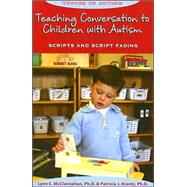
| Preface | ix | ||
| About This Book | xi | ||
| Chapter 1 Why Doesn't He Talk to Us? | 1 | (4) | |
| Chapter 2 What Are Scripts? What Is Script Fading? | 5 | (4) | |
| Chapter 3 Scripts, Script Fading, and Activity Schedules | 9 | (4) | |
| Chapter 4 Building Prerequisite Skills: Scripts for Children Who Do Not Yet Talk | 13 | (8) | |
|
|||
|
|||
|
|||
|
|||
|
|||
| Chapter 5 Preparing to Teach | 21 | (4) | |
|
|||
|
|||
|
|||
|
|||
|
|||
| Chapter 6 Teaching Children to Use Scripts: Prompters and Conversation Partners | 25 | (10) | |
|
|||
|
|||
|
|||
|
|||
|
|||
|
|||
| Chapter 7 Scripts for Children Who Say Words or Phrases | 35 | (10) | |
|
|||
|
|||
|
|||
|
|||
| Chapter 8 Measuring Scripted and Unscripted Interaction | 45 | (8) | |
|
|||
|
|||
|
|||
| Chapter 9 More Scripts and More Interaction Opportunities | 53 | (12) | |
|
|||
|
|||
|
|||
|
|||
|
|||
| Chapter 10 Scripts for Beginning Readers | 65 | (10) | |
|
|||
|
|||
|
|||
| Chapter 11 Scripts for More Accomplished Readers | 75 | (10) | |
|
|||
|
|||
|
|||
|
|||
|
|||
| Chapter 12 Measuring More Complex Conversation | 85 | (6) | |
|
|||
|
|||
| Chapter 13 Using Scripts to Promote Peer Interaction | 91 | (12) | |
|
|||
|
|||
|
|||
| Chapter 14 Teaching Young People to Create Their Own Scripts | 103 | (8) | |
|
|||
|
|||
| Chapter 15 Scripts for Nonreaders and People with Severe Disabilities | 111 | (8) | |
|
|||
|
|||
| Chapter 16 Making It Work | 119 | (8) | |
|
|||
|
|||
|
|||
|
|||
| Chapter 17 Solving Problems | 127 | (11) | |
| Appendix A Audio Card Readers | 138 | (1) | |
| Appendix B Data Sheet Used to Measure the Progress of a Child Who Is Not-Yet-Verbal | 139 | (1) | |
| Appendix C Daily Individual Progress Report Chart for a Child Who Is Not-Yet-Verbal | 140 | (1) | |
| Appendix D Data Sheet Used to Measure the Progress of a Child Who Says Words or Phrases | 141 | (1) | |
| Appendix E Daily Individual Progress Report Chart for a Child Who Says Words or Phrases | 142 | (1) | |
| Appendix F Data Sheet for Scoring Scripted and Unscripted Interaction | 143 | (1) | |
| Appendix G Data Sheet for a Child Who Uses Sentences | 144 | (1) | |
| Appendix H Button-Activated Voice Recorders | 145 | (1) | |
| Appendix I Hand Counter | 146 | (1) | |
| Appendix J Materials Needed for Script-Fading Programs | 147 | (2) | |
| References | 149 | (4) | |
| Glossary | 153 | (4) | |
| Index | 157 |
The New copy of this book will include any supplemental materials advertised. Please check the title of the book to determine if it should include any access cards, study guides, lab manuals, CDs, etc.
The Used, Rental and eBook copies of this book are not guaranteed to include any supplemental materials. Typically, only the book itself is included. This is true even if the title states it includes any access cards, study guides, lab manuals, CDs, etc.